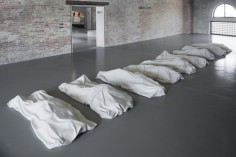MAURIZIO CATTELAN
マウリツィオ·カテラン
Маурицио Каттелана
all

source: dailyserving
Maurizio Cattelan. “All,” 2007. Marble. As installed at the New Museum, New York.
I had previously seen several of the works displayed at the Guggenheim under more “conventional” circumstances. A series of nine Carrara marble sculptures resembling bodies under sheets, All (2007) was displayed almost alone in a gallery at the New Museum for the 2010 exhibition, Skin Fruit. In this context, the work was arresting, a disquieting reflection on the history of needless and anonymous death.
.
.
.
.
.
source: guggenheimorg
My work can be divided into different categories. One is my early work, which was really about the impossibility of doing something. This is a threat that still gives shape to many of my actions and work. I guess it was really about insecurity, about failure. We can have a chapter here called “Failure.”
For Cattelan, the art world is the analyst’s couch. Since the beginning of his career as an artist during the late 1980s, he has freely enacted his vulnerabilities, giving them physical form and a distinct narrative. Without being directly autobiographical, Cattelan’s early work drew on his own emotional and psychological experiences. His goal, however, was not to invoke specific events or individuals but rather to summon up states of mind or emotions. While the work is not directly about him, he uses himself as a character whose foibles and travails invoke an empathetic identification on the part of the viewer.
Motivated at first by an almost paralyzing fear of disgrace, Cattelan created what can be characterized as an aesthetic of failure—an attitude that serves to manage expectations and make excuses before the fact. For his first solo exhibition in 1989, Cattelan was so disappointed with his production that he posted on the gallery’s locked front door a simple placard that read Torno subito, or “Be back soon.” This everyday shop sign reveals the artist’s discomfort with the critical judgment that comes with showing work in a public exhibition.
Cattelan has stated, “I have been a failure for most of my life. I couldn’t keep a job for more than two months. I couldn’t study: school was a torture. And as long as I had to respect rules, I was a disaster. Initially art was just a way to try a new set of rules. But I was very afraid of failure in art as well.”
In an untitled work from 1997, a taxidermied ostrich buries his head in the gallery floor, unwilling to participate in the exhibition and hiding in full view. The work was shown in the exhibition Fatto in Italia (Made in Italy) at the Institute of Contemporary Arts, London, prominently signaling the growing significance of contemporary Italian artists. Cattelan expressed his feelings toward the recognition with an image of ambivalence. The ostrich elicits a sense of vulnerability. The flightless bird is in the gallery space seems to wish it were elsewhere, an attitude that may also have applied to the artist. Without a pedestal, the sculpture is stripped of any monumentality, and the viewer is transported into the surreal space of the artwork.
.
.
.
.
.
.
source: estudi-arteblogspot
Artista italiano contemporáneo, autodidacta, nacido en Padua en 1960 que vive actualmente en Nueva York. Su propuesta artística se ubica entre la escultura y el performance (acción artística donde un artista o un grupo de artistas participa con el uso del cuerpo como elemento escultórico “en vivo” frente al público), trabajando principalmente en el género de instalación.
El sentido del humor y la trasgresión de los símbolos establecidos constituyen sus principales armas expresivas. En una muestra en el MOMA de Nueva York, en 1998, hizo que un actor vestido de Picasso, provisto de una careta que caricaturizaba el rostro del pintor, saludara a los visitantes al mejor estilo Disney World, un modo de llamar la atención sobre la inercia mercantil y espectacular del arte contemporáneo. La ironía hacia el mundo del arte no la propone a modo de subvertir un sistema del que él forma parte, sino que parecen ser formas de insubordinación a valores y reglas de la sociedad contemporánea, sin que ello lo lleve a tomar posturas morales o ideológicas precisas. El mensaje parece ser que se puede sobrevivir y utilizar el sistema sin ser consumido por él.
Frank & Jamie. Ha sido interpretada como una imagen invertida del poder y una declaración acerca de la seducción de la autoridad.
.
.
.
.
.
.
.
source: sasha-sh2000livejournal
Маурицио Кателлан (Maurizio Cattelan) —итальянский художник.
Маурицио провокатор по натуре, каждая его новая инсталляция, это вызов обществу и художественному истеблешменту, это очень роднит его с русскими футуристами – Бурлюком, Маяковским, Крученых.
Маурицио легко представить пишущим манифест “Пощечина общественному вкусу” или “Простое как мычание”.
Чего стоит его инсталляция “La Nona ora” изображающая Папу римского, упавшего от удара метеорита, или “Him” с Гитлером стоящим на коленях.
Но творчество Кателлана это не только эпатаж, и желание скандала, не зря в творчестве художника так много инсталляций с мертвыми животными в странных и даже пугающих позах, это роднит Маурицио с другим хулиганом от искусства Дамиеном Херстом.
И Дамиен и Маурицио ставят своим творчеством похожие вопросы.
Где грань между искусством и китчем? Между шокирующим натурализмом и бессмысленно жестоким трешем? Должно ли искусство быть гуманно и есть ли граница гуманизму?
И главный вопрос что есть искусство? и не стало ли в последнее время в нем слишком много грязи (не зря в своей инсталляции “Untitled” 2009 Маурицио прислонил к белому хосту метлу для уборки дома).
И кто знает может быть выворачивая наизнанку все общественные нормы морали, и ставя с ног на голову привычные нам понятия (в этом смысле очень показательна его работа “Frank & Jamie” изображающая двух полицейских стоящих на головах) Маурицио достигает обратного эффекта возвращая нам понимание, что есть уродливое и прекрасное, есть предательство и подвиг, добро и зло.
И это понятия не перестали существовать, несмотря на все постмодернистские декларации.

